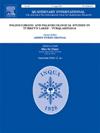Climate frameworks for the Middle Stone Age and Later Stone Age in Northwest Africa
IF 1.9
3区 地球科学
Q3 GEOGRAPHY, PHYSICAL
引用次数: 0
Abstract
This paper examines climate conditions in Northwest Africa for Marine Isotope Stage 4, 3, and 2 (71,000–11,000 years ago) and their impact on the distribution of potential suitable areas on a regional scale. The analysis uses climate simulations to model: 1) the geographical extent and variability of macro-refugia based on ethnographic data; and 2) the frequency of suitable areas based on climate ranges obtained at dated archaeological occupations. The results include the production of maps of MSA and LSA site distribution, and annual precipitation and temperature values for each dated human occupation. The macro-refugia models confirm the persistence and low variability of ecological macro-refugia along the Mediterranean coast but reveal limitations in Central Sahara. Macro-refugia models aligned closely with climate-archaeological models, except for Marine Isotope Stage 4. Despite the general spatio-temporal limitations of climate simulations, our study offers valuable data to be integrated with local environmental proxies. These climate frameworks and insights can contribute to the exploration of past human demography, connectivity and human-environment interactions across different scales of analysis.
西北非洲石器时代中期和后期的气候框架
本文研究了西北非洲海洋同位素阶段4、3和2(71000 - 11000年前)的气候条件及其在区域尺度上对潜在适宜区分布的影响。该分析利用气候模拟模拟:1)基于民族志数据的宏观难民的地理范围和变异性;(2)适宜区域的频率基于在考古职业中获得的气候范围。结果包括制作MSA和LSA站点分布图,以及每个人类职业的年降水量和温度值。宏观难民模型证实了地中海沿岸生态大难民的持久性和低变动性,但揭示了撒哈拉中部的局限性。除了海洋同位素阶段4外,宏观避难所模型与气候考古模型非常接近。尽管气候模拟普遍存在时空局限性,但我们的研究为与当地环境代理相结合提供了有价值的数据。这些气候框架和见解有助于在不同的分析尺度上探索过去的人口统计、连通性和人与环境的相互作用。
本文章由计算机程序翻译,如有差异,请以英文原文为准。
求助全文
约1分钟内获得全文
求助全文
来源期刊

Quaternary International
地学-地球科学综合
CiteScore
5.60
自引率
4.50%
发文量
336
审稿时长
3 months
期刊介绍:
Quaternary International is the official journal of the International Union for Quaternary Research. The objectives are to publish a high quality scientific journal under the auspices of the premier Quaternary association that reflects the interdisciplinary nature of INQUA and records recent advances in Quaternary science that appeal to a wide audience.
This series will encompass all the full spectrum of the physical and natural sciences that are commonly employed in solving Quaternary problems. The policy is to publish peer refereed collected research papers from symposia, workshops and meetings sponsored by INQUA. In addition, other organizations may request publication of their collected works pertaining to the Quaternary.
 求助内容:
求助内容: 应助结果提醒方式:
应助结果提醒方式:


